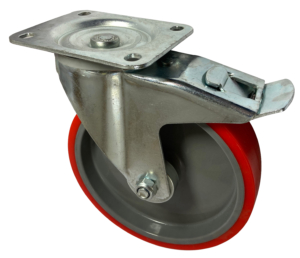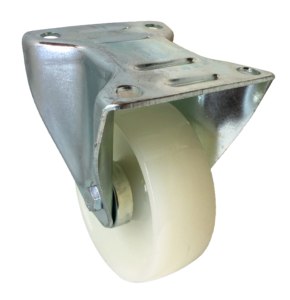The Ultimate Guide to Choosing the Right Castors for Your Projects
Are you a DIY enthusiast or someone looking to make you static equipment mobile? If so, you may have considered using castors to add mobility and versatility. Castors are wheels mounted into a housing which is either Fixed (also known as Rigid) or Swivelling. They make it easier to move heavy objects or furniture. However, choosing the right castors can be a bit overwhelming with the multitude of options available. In this ultimate guide, we will provide you with tips and recommendations to help you select the perfect castors for your needs.
1. Understanding the Types of Castors
Before you dive into selecting castors for your projects, it’s essential to understand the different types available. Castors can vary in terms of size, material, and design. Read below on the difference between swivel and fixed castors and what to consider on your buying journey.
Swivel Castors vs. Fixed Castors
Swivel castors rotate 360 degrees, allowing for maximum manoeuvrability. Fixed castors, on the other hand, move only in a straight line. Depending on your project, you may need a combination of both types for optimal mobility.
Swivel & Brake Castor Fixed Castor
Wheel Material
Castor wheels come in various materials, such as rubber, plastic, polyurethane, and metal. Each material has unique properties, so consider your project’s requirements. For instance, rubber wheels provide excellent vibration absorption, making them and excellent choice where user comfort and noise reduction is important. Hard Tread Wheels like Cast Iron and Nylon durability and high load capacity and are often the most economical choice, but vibrations will not be absorbed and they are noisier than softer treads.
2. Assessing Your Project
Now that you have a basic understanding of castor types, it’s time to assess your project’s specific needs. Ask yourself the following questions:
What’s the Total Weight to be supported?
Determine the total weight of the item you plan to equip with castors. This includes the weight of both the equipment AND, if applicable, the maximum weight of the load to be carried. This will help you select castors with an appropriate load capacity to ensure stability and safety.
The first thing to be aware of is that the load capacity in a castor’s specifications is usually the load capacity of a single castor and NOT a set of castors. The second thing to be aware of is that the castor configuration will affect the minimum castor’s load capacity you need. The most common castor configurations are (Click here for more information on Load Capacity):
Four castors configuration:
- Each castor must be able to carry at least (Maximum Load + Weight of Transport Equipment) / 3, that is, 33% of gross weight.
Three castors configuration:
- Each castor must be able to carry at least 40% of gross weight.
- This configuration is only suitable for small trolleys and light loads.
Six castors configuration with pivoting central Fixed Castors:
- This configuration has two central fixed castors that have a larger overall height than both the front and back two.
- The additional overall height is typically achieved by either using larger middle castors (usually the next size up) or adding packing plates to achieve 25mm of extra height.
- It is a configuration mainly used on long platform trolleys to maximise manoeuvrability while maintaining control.
- For this configuration, the two central fixed castor must be able to hold at least 50% of the total gross load each.
Where Will You Use the Castors?
Consider the environment in which your project will be used. If it’s an indoor project, you can opt for castors with almost any wheels. However, it is most usual for indoor equipment to use softer tread wheels as they are less noisy and the floor is more likely to be in good condition. if your DIY creation will be exposed to outdoor conditions or rough terrain, you’ll need castors with wheels designed for such environments.
How Often Will You Move the Project?
Think about how frequently you’ll be moving your project around. If it’s something that needs to be moved frequently, invest in high-quality swivel castors for ease of manoeuvrability.
3. Selecting the Right Castor Size
Castor size matters, especially when it comes to stability and load-bearing capacity. The size of the castor affects how well it distributes weight and handles rough terrain. Here’s what you need to know:
Diameter
The diameter of the castor wheel impacts how easily it can roll over obstacles. Larger wheels handle rough terrain better, and are generally easier to move while smaller wheels are more suitable for smooth flooring and where the weight being carried is low.
Height
Consider the overall height of your project with the castors attached. Ensure that the added height won’t cause any stability issues or make your project too tall for its intended use. The overall height illustrated below:
4. Choosing the Ideal Mounting Type
Castors can be mounted in different ways, depending on your project’s requirements. The most common mounting options are:
Plate Mount
4-fixing hole Plate-mounted castors have a flat rectangular or square plate that attaches to the bottom of your project. They are versatile and easy to install, making them suitable for various DIY and commercial/industrial applications.
Single Bolt Hole Fitting
Single Bolt Hole castors have a single, central, fixing holt in which a suitable bolt can be inserted though. Alternatively, if you are using hollow tubing, an expander fitting can be used.
5. Consider Special Features
Depending on your DIY project, you may benefit from castors with special features:
Brake Mechanisms
Some castors come with built-in brakes that allow you to lock the wheels in place, adding stability when needed. There are two main types of brakes. A Wheel Brake that locks the wheel or a Swivel and Wheel Brake (also known as a Total Stop Brake) that locks the wheel and the castors. Browse Braked Castors here.
Noise Reduction
If noise is a concern, look for castors with noise-reducing features like soft treads or rubber wheels.
Browse our castors online
Choosing the right castors for your mobility projects is essential to ensure functionality, safety, and longevity. By understanding the different types of castors, assessing your project’s specific needs, selecting the appropriate size and mounting type, and considering any special features, you can confidently enhance your equipment with the perfect castors. So, roll on and take your projects to new heights with the mobility and versatility that castors provide. View our range of castors online today.





